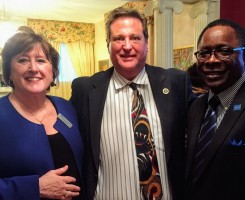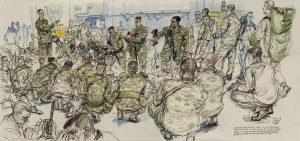So I try to be like you
Try to feel it like you do
But without you it’s no use
I can’t see what you see
When I look at the world
~U2
I think we would all agree that sight is a miraculous gift – an ability allowing us to interpret what we visualize according to its physical qualities. While this ability belongs to all creatures, human and animal, the functional variation among the species is quite broad.
The difference in perceived images among species depends on eye structure, placement and brain connection.
Humans have depth perception, visual range and a trichromatic color range. Cats and dogs have fairly poor vision in general, although have better perception and depth. Horses have a wide visual range except for what is immediately in front of or behind them, due to the placement of their eyes and lack of binocular vision. Monkeys see similarly to the way humans do with the same trichromatic color range, although are prone to color blindness. The vision of fish is more about light perception. Pigeons have more cones in their eye compared to that of humans, giving them an ability to see millions of color hues through the multiple spectral bands in their eyes. Insects, with their segmented eye structure, see more clearly than humans and are faster at detecting movement. Dragonflies’ brains work so fast, they see the world in slow motion!
In learning about the particular visual acuities of the different species, we can begin to appreciate the diverse and distinctive functioning of each one, as well as recognize inherent behavioral barriers, helping us to better understand operating styles by seeing the world through their eyes!
This week, the 114th Supreme Court Justice of the United States, Brett Kavanaugh, was sworn into office. Besides being the new Supreme Court Justice, his selection also marks the beginning of a significant transition in the Supreme Court – to that of being considered the most conservative choice since 1937. While a majority of voters supported his nomination, there were others who strongly expressed their disapproval.
We all have our own unique lens through which we see life. Although as humans, we generally share the same eye structure and visual lens through which we interpret images, the other sensory information through which we interpret life, is quite varied and dissimilar.
In the 2008 book published by author and psychologist, Pamela Hayes, Addressing Cultural Complexities in Practice, she explains a framework that provides understanding regarding the multidimensional complexities of both individual and cultural identity.
Through the use of the acronym ADDRESSING, she identifies 10 forces that factor into creating the diversity of lenses through which we all see life, giving us greater clarity for seeing into the world of others.
These factors include; Age, Developmental disability, Disability acquired, Religion, Ethnicity and race, Socioeconomic status, Sexual orientation, Indigenous population, National origin and language, and Gender. Other aspects of diversity also include Veteran and Military culture and Mental Health.
Being able to see the world through the eyes of another, is a quality known as empathy, and one that can be difficult, if not impossible when reading, watching or listening to what we are exposed to via news feeds.
But in the everyday interactions of our own worlds, it is a rewarding quality we can integrate with intentionality, for the purpose of clarifying misunderstandings, broadening perspectives and connecting authentically with others.
And it doesn’t take much effort – just a little ADDRESSING and spending some time with our animal and insect friends.
For the Support of Your Life
For the Many Sides of Life
Paulette Jackson LPC-MHSP
photo credit: Ginny Mackles













